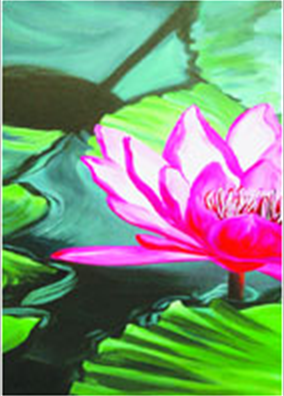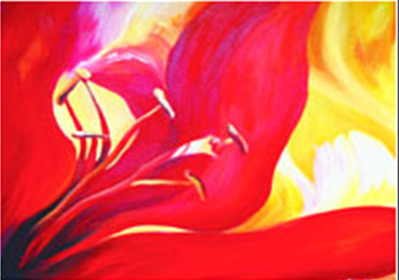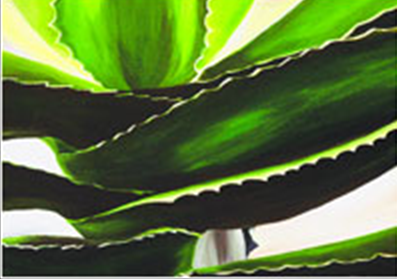Aliya Chinoy
(Created page with "{| class="wikitable" |- |colspan="0"|<div style="font-size:100%"> This is a collection of articles archived for the excellence of their content.<br/>You can help by converting...") |
Revision as of 19:40, 15 October 2013
This is a collection of articles archived for the excellence of their content. Readers will be able to edit existing articles and post new articles directly |
Aliya Chinoy
Romantic Transport
By Shamim Akhter
Apparently one sees a matter of fact objectivity on Aliya Chinoy’s latest canvases on display under the title ‘Impressions’. Her 33 paintings treat flowers in various forms. In some of her paintings, she magnifies and abstracts the details of her botanical subjects, so that often a large canvas is filled with but a fragment of the intersection of petals.
Despite her apparent matter of fact objectivity, Chinoy seems to have experienced a sense of romantic transport in the closely observed detail of nature. These flowers have a yearning, reaching organic quality, and her botany seems to function as a metaphor for zoology. That is, her plants are animistic; they seem to grow because of will, not merely because of the blind interactions of the unfolding of the genetic code with water, sun and minerals. Thus, Chinoy attempts at drawing parallels between human beings and plants.
If so, then there remains no room for denying any attempt to portray sexual imagery in these flowers. The edges of the petals in their folds and convolutions are frequently reminiscence of parts of the male and female body. It is here that she departs from Georgia O’Keefe (1887-1986). In 1924, O’Keefe began to paint enlarged flower pictures such as Light Iris. O’Keefe only sought objectivity and denied any attempt to portray sexual imagery in these flowers. She said that who saw so; they were speaking about themselves and not her.
These flowers have a yearning, reaching organic quality, and her botany seems to function as a metaphor for zoology.
This time at Zenaini Gallery, Karachi based Chinoy’s body of work includes new elements to indicate her moving on from the object she has chosen as her subject. Some of her paintings take account of delightful fields of flowers swinging on the music of breeze. There also is introduction of water when she focuses on water lilies. There is one painting which is nothing but a landscape.
Earlier in 2000, Chinoy displayed nine figurative paintings. She called them pictorial insight into the world of momentary parallels. Her nudes were more or less like those of the late Nagi; unabashedly exhibiting flesh. Through her bright palette she had tried to convey the spirit of a woman.
According to her the spirit of a woman runs parallel to nature. She attributed the qualities of strength, and submissiveness, sensitivity and hardness to a woman. Then she reflected these attributes through her palette on her canvases.
By using cool and warm colours she portrayed moods and feelings. She found beauty in dark colours. She believed that even images that seemed dark could have a celebratory essence. Just as nature is working under a system of balance, a woman brings balance in her life through strength, sacrifice or submission. She calls her floral work the translation of her figurative renditions.
Switching over from women to flowers was not the result of a conscious decision. It was the outcome of lack of material. Chinoy could not find a female model for her paintings when she moved to Islamabad so she turned her attention to the city’s beautiful flowers which attracted her in form and spirit as well as colour spectrum during her morning walks. She discovered their relationship with women in symbolic ways. Both are beautiful and fragile and no more wanted when they are withered. The mystery and intrigue she discovered in flowers was no less than what she had found in female body.
Each flower — big and small — opened up a new world for her. She found philosophy of life in its fragile beauty. Upon close observation she noticed that like human beings, no two flowers, even of the same species, are alike.
Chinoy’s titles give new meaning to her flowers; these introduce them to the viewer. She treats her object as humans and focuses on their issues one by one or only on a part of it by portraying a flower in the full or blowing up just a part of it. She refers to the various aspects of a flower as characteristics of human beings. She is excellent with colour fusion. Chinoy says, “Each diptych has its own relevance, depending on how you place and perceive it.”
Aliya Chinoy obtained her Bachelor of Fine Arts in Textile Design (honours) from Moore College of Art and Design, Philadelphia, PA in 1992. Prior to her BFA, she did a Foundation Course from Putney School of Art, London in 1988. She also did 1st year BTEC from Chelsea School of Art, London in 1989. She has been taking part in group exhibitions at home and abroad since 1990.
Top: In passing Above: Turning Left: Constructing her


